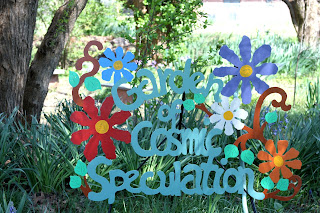Garden Art from Three Doors North in Hutchinson KS

We discovered a metal artist studio in Hutchinson KS, called Three Doors North. We asked the owner to make a sign for us for our garden, "Garden of Cosmic Speculation" that we had heard about through a novel. The actual Garden of Cosmic Speculation is a 30 acre creation in Scotland. Our garden is named that out of pure whimsy. Jon painted the plain metal sign. Love Like a Rock One of the first pieces we purchased is the metal heart she called "Love Like a Rock". We bought it in a garden gift shop in KS. You can check out Three Doors North at their Facebook page https://www.facebook.com/ThreeDoorsNorth/?fref=ts The owner is Heike Kirk-Ettwein. Here is her Facebook page https://www.facebook.com/heike.kirkettwein?fref=ts The work is wonderfully creative and Heike is a delight to meet and talk with about her art and her methods. One of her other pieces, this metal butterfly is no longer being made so we love it twice as much.


